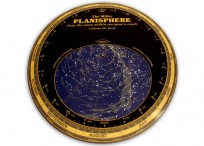SUGGESTED STARGAZING BASICS RESOURCES – by Darrell Heath
 Amateur astronomy can feel like a bewildering hobby to get into and with a subject as broad as the universe itself it is no wonder that so many people feel a bit disoriented when they first begin to dip their toes into the water.
Amateur astronomy can feel like a bewildering hobby to get into and with a subject as broad as the universe itself it is no wonder that so many people feel a bit disoriented when they first begin to dip their toes into the water.
Here are my personal suggestions for various resources that can help you to navigate your way into the hobby. Just remember to start with the very basics (ie. learn a few of the more conspicuous constellations as a first step) and the rest will follow.
Amateur astronomy can be approached from any level of expertise: from the total novice to the advanced amateur; you can take your explorations as far as you want and become a skilled astrophotographer, a citizen scientist, or just a casual observer.
Above all else, have fun and enjoy being outside and looking up in both awe and wonder!
NOTE: an * indicates my personal favorites. This list is certainly not meant to be exhaustive but is my own personal attempt to provide you with various resources to help you along in your explorations of the universe. Feel free to email me with any
questions you might have at DRHEATH@ualr.edu
BOOKS:
*Night Watch by Terence Dickinson, 2006, Firefly Books (highly recommended)
The Monthly Sky Guide by Ian Ridpath, 2009, Cambridge University Press
*365 Starry Nights by Chet Raymo, 1982, Fireside Books
*The Stars (Second Edition) by H.A. Rey, 1980, Houghton Mifflin Company
(Don’t let the fact that this book was written by Curious George’s creator, it is a very
readable and enjoyable book for just about anyone and if Albert Einstein himself
recommends it then you know that you are not being led to far astray)
*Find the Constellations by H.A. Rey, 1982, Houghton Mifflin Company
Princeton Field Guide to Stars and Planets by Ian Ridpath, 2008, Princeton
University Press
Peterson Field Guide to the Stars and Planets by Jay M. Pasachoff, 2006, Houghton Mifflin
*Smithsonian Nature Guide: Stars and Planets by Robert Dinwiddie, et al, 2012, DK Books
*National Geographic Backyard Guide to the Night Sky by Howard Schneider,
National Geographic
*Stargazing For Dummies by Steve Owens, 2013, John Wiley and Sons
MAGAZINES: (many of these are available in ebook formats)
Sky & Telescope
Astronomy
*SkyNews (a Canadian Magazine suitable for the beginning stargazer)
British Magazines:
Sky at Night
*All About Space
Astronomy Now
PODCASTS:
*AstronomyCast (http://www.astronomycast.com)
365 Days of Astronomy (http://cosmoquest.org/x/365daysofastronomy/)
Planetary Radio (http://www.planetary.org/multimedia/planetary-radio/)
*StarDate (https://stardate.org You can also listen to the radio show on KUAR)
*Sky and Telescope’s Astronomy podcast (http://www.skyandtelescope.com/observing/astronomy-podcasts/)
WEBSITES:
*Bad Astronomy (http://www.slate.com/blogs/bad_astronomy.html)
*Astronomy Picture of the Day (http://apod.nasa.gov/apod/archivepix.html)
*Universe Today (http://www.universetoday.com)
*Sky & Telescope (http://www.skyandtelescope.com)
*Astronomy Magazine (http://www.astronomy.com)
*EarthSky (http://earthsky.org)
TV & DVD
*The Universe DVD sets by The History Channel
*Cosmos (both the Sagan and the Tyson series)
How The Universe Works
The Night Sky UALRTV Series (YouTube or Comcast 61/UVerse 99)
PLANISPHERES:
 A planisphere is an easy to use star map that shows you which constellations, stars,and deep sky objects are in the sky at any given time of the year. They are usuallymade of two sections: an inner rotating disc of plastic, cardboard, or paper with amap of the entire sky showing various constellations and celestial objects. Theoutside edge of the disc shows the days and months of the year. The fixed outer dischas the hours of the day marked on the outer edges. Simply align the inner wheelwith the days and months with the hour in which you are viewing and you will havedisplayed what is up in your sky for that date and time. Most good bookstores havethese in stock in their science book sections and they typically range in price from$10-$15.
A planisphere is an easy to use star map that shows you which constellations, stars,and deep sky objects are in the sky at any given time of the year. They are usuallymade of two sections: an inner rotating disc of plastic, cardboard, or paper with amap of the entire sky showing various constellations and celestial objects. Theoutside edge of the disc shows the days and months of the year. The fixed outer dischas the hours of the day marked on the outer edges. Simply align the inner wheelwith the days and months with the hour in which you are viewing and you will havedisplayed what is up in your sky for that date and time. Most good bookstores havethese in stock in their science book sections and they typically range in price from$10-$15.
STARGAZING APPS:
*StarWalk
SkySafari
*Sky Guide
*Moon Maps
Deluxe Moon
*Flyby
Sputnik
These last two will give you notifications for when the International Space Station,Iridium flares and other satellites will pass over your area.
*Spotthestation.nasa.gov/ is where you can sign up for free email notifications as towhen the ISS will flyover your location as well.
SOFTWARE:
Starry Night
Stellarium (a free planetarium software available online to download to yourcomputer. A great resource as to what’s up in your sky)